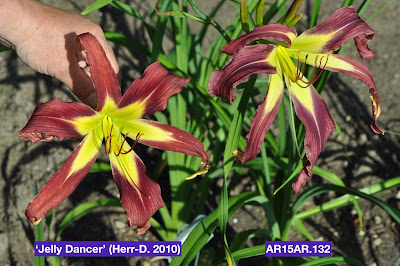37", EM or M, 6", Rosy purple with dark purple eye and green throat, Dormant, Diploid
(Protostar x Jelly Dancer)
It's been a while since I've had the desire or time to write a blog post-- but I'm back! This season saw the first bloom for most of my small crop of 2015/2016 seedlings, and AR15AR.132 has been one of the most exciting.
I crossed the two parents with no particular goal in mind; they are both dark-colored unusual forms, and so the cross seemed a logical one to make if I wanted to create my own line of like-colored cascades. But subsequent observation of the parents in my garden has allowed me to realize that both plants present their own unique flaws. 'Jelly Dancer' (Herr-D., 2010) makes a striking clump, but seems to be exceptionally susceptible to thrip damage so severe that often some blooms are gnarled and so hideous that I'm resorted to liveheading at 7 a.m. Each bloom on 'Protostar' (Mahieu-Burris, 2007) by contrast opens perfectly; my only complaint is that it tends to slick on hotter days, something that 'Jelly Dancer' does not do. This cross, then, had the potential to produce seedlings free of the parents' issues. And this is what I may have achieved in AR15AR.132!
 |
| 'Protostar' (Mahieu-Burris, 2007). Notice the slicking it presents, even at the early hour of 7 a.m. |
The description for 'Protostar' on the original site says that the plant "has the genes for clear purple-blacks" that take a "spidery or UF" form; its offspring proves this to be the case. I measured AR15AR.132 to see if it's a true spider, but it's not quite; I'll content myself by labeling it as a spidery cascade.
In the photo above, a detached bloom from 'Jelly Dancer' is next to AR15AR.132, which appears much more purple than its maroon parent. It is also of note that AR15AR.132 has more of a drooping cascade form than either of its parents, something that I find attractive.
There are only two issues that I have found with this seedling. The first is that the color fades, a fault I don't think is that detrimental to the health of the plant (see below).
 |
| There is an eight hour difference between the two photos. There is also a considerable difference in the quality of the natural light. |
The second is that the scape leans, but there is a caveat to this otherwise deal-breaking flaw: the plant currently grows in an area that is heavily shaded by 2 or 3 p.m., and I've observed many scapes lean towards the sun over the years in this location. The issue may resolve itself in a couple of years when I transplant the seedling to a more sunny bed for further observation.
But what a scape it is! This was its first year blooming, and an elegant terminal-Y and one lateral branch yielded 16 buds that bloomed over the course of three weeks... it promises to make a fine clump! Increase is slow thus far, with only one fan.
I'm excited to see how this seedling does in the coming years!




